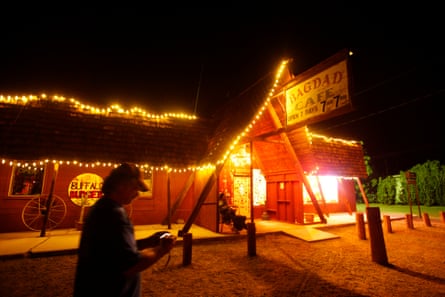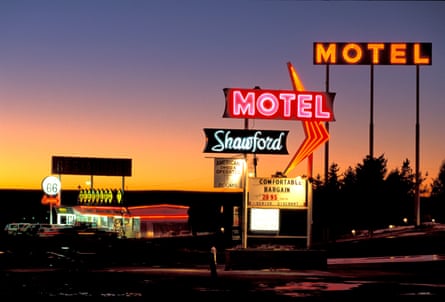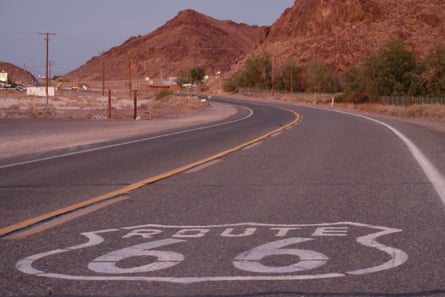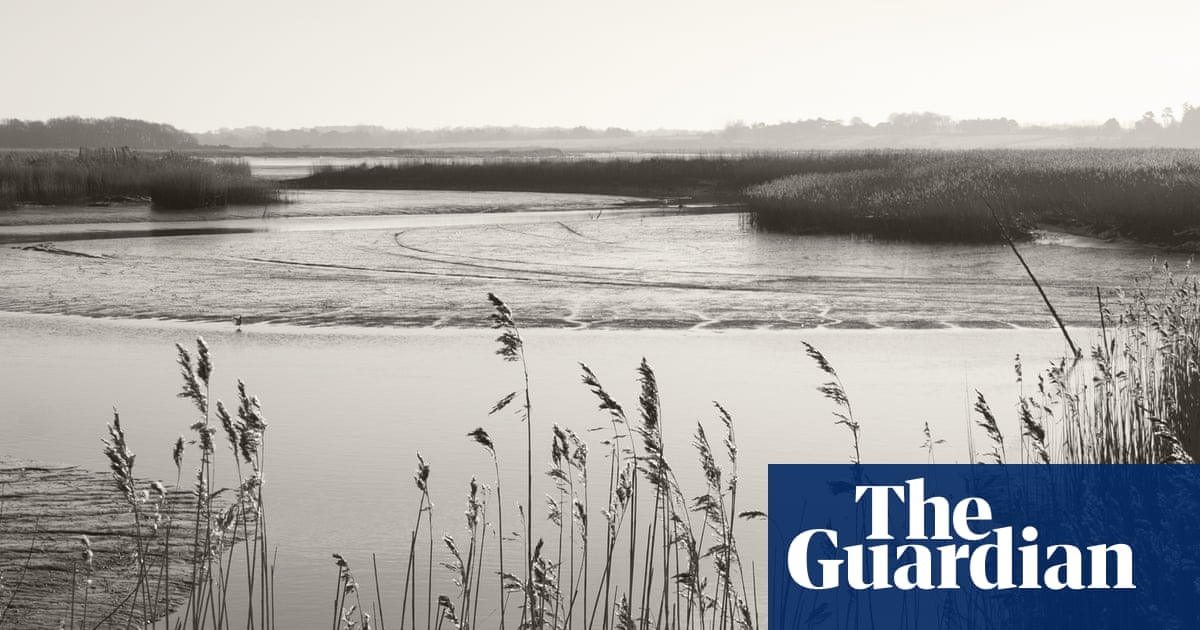The tiny desert cafe, caught in a desolate middle between Los Angeles and Las Vegas, had only been open for five minutes when the first customers of the day ambled in from the already blistering heat.
It was a Friday morning in June, sand swirling outside across the cracked street and towards the Bagdad Cafe’s front door. In the same parking lot, a 1950s-era sign advertised a motel that no longer exists. In the distance, only a few surviving businesses remained: a small community center, a veterans organization and a long-standing roadhouse bar popular with locals. A few miles to the north, an entire neighborhood was abandoned in the 1990s after mounds of blowing sand swallowed it whole; today, only rooftops and chimneys peek out from the towering sand dunes.
Despite the general ghost town-like atmosphere, the cafe’s early-morning visitors were giddy.
Neilson Lopes, a tourist from Brazil, happily perused a rack of neon T-shirts and snapped photos of the dimly lit cafe. He and his wife had flown and driven, on the back of a motorcycle, thousands of miles to be there, in the middle of nowhere.
“I’ve planned this trip for 10 years,” he said. “For decades, maybe.”

Because while this Mojave Desert outpost – a tiny settlement of 2,000-some people called Newberry Springs– may look deserted to the uninitiated, it’s positioned on one of the most famous roads in the world: Route 66. The roughly 2,400-mile (3,900km) route stretches from the California coast to Chicago, connecting both small towns and sprawling metropolises across the country. For many, the road embodies a sense of quintessential Americana, from its quirky roadside kitsch to its historic roots.
And next year, Route 66 is turning 100 years old. Nationwide preparations for the big anniversary have been underway for years: caravans of people are planning to drive the entirety of the route, and Congress even created a Route 66 Centennial Commission in 2020 to commemorate the milestone.
In small towns such as Newberry Springs, and an even tinier neighboring community 10 miles west called Daggett, residents are hoping the anniversary will bring in a flood of extra visitors. The Bagdad Cafe, where the 1980s cult classic film by the same name was shot, currently sees about 6,000 tourists each month. Locals anticipate that those numbers will double in 2026 – and they’re planning other ways to capitalize on the centennial, too.
“We’re a teeny, weeny, little slice of Route 66,” said Renee Kaminski, a co-owner of Newberry Spring’s historic bar.
“But we’re a mighty one.”
A desert town ‘frozen in time’
Out in remote Newberry Springs, an unincorporated community that lacks an official mayor or city council, a handful of residents have instead informally banded together to start sharing ideas for Route 66’s centennial.
One of them, Karla Claus, has become a de facto ambassador for the town.
Wearing a Route 66 crown atop an American flag cowboy hat, unbothered in a pair of jeans even as the thermostat topped 100F (38C), she described her grand plans for the centennial one recent summer afternoon.
This anniversary, she said, is a chance for Newberry Springs to be reborn.
“My vision is that we’re going to be one of the go-to destinations for those caravans [of Route 66 fans],” she said. “That we’re saying to those people: ‘Make sure you come here.’”
To make that vision a reality, Claus, who is also the vice-president of the local chamber of commerce, recently received a micro-grant to start leading custom, history-focused Route 66 tours.

And there’s a lot of history to be shared.
In 1926, as millions of Americans were buying their first car and taking to the open road, Route 66 was created as part of the nation’s first federal highway system. Car ownership had newly exploded; the Model T had only been introduced about two decades prior.
The route was famously dubbed “Mother Road” by John Steinbeck in his classic 1939 novel The Grapes of Wrath. At the time, before the route became better known for its flashing neon signs, old-school diners and eccentric roadside attractions, the road was a migration route for climate refugees fleeing the Dust Bowl. Hit hard by severe drought, dust storms and the Great Depression, hundreds of thousands of people funneled out of the Great Plains via the now-celebrated route and headed west.
In Newberry Springs, Route 66 brought about a kind of heyday in the 1950s. Because of the constant flow of traffic, its main street was bustling: there were more businesses, a couple hotels and a popular rest stop with an expansive swimming pool.
But when interstate I-40 came along in the 1970s, it spelled disaster for Newberry. The newer, faster freeway was laid parallel to that stretch of Route 66, meaning that drivers would now fly right by the small town without ever noticing it.
The development was a death knell for other tiny towns across the state – and throughout the country. The animated movie Cars even spotlighted the issue by creating the fictional Radiator Springs: a forgotten town on Route 66 that withered away after it was bypassed by the interstate.
Rose Beardshear, the chamber of commerce’s treasurer, said the film is bringing the plight of Route 66 to life for the younger generation. Beardshear was driving through the nearby town of Daggett with her granddaughter when the nine-year-old suddenly said: “This is like the movie with the cars.”

But the boom-and-bust cycle for Newberry didn’t end with the interstate.
The indie film Bagdad Cafe, about a dilapidated desert cafe and a stranded German tourist who finds an unexpected community there, brought waves of international tourists to Newberry; the movie was a massive hit in France and Germany. When the pandemic halted tourism, especially from other countries, the real-life Bagdad Cafe shuttered. It only reopened again recently (without serving food), after the owner started a GoFundMe to make necessary repairs on the building.
Part of Newberry’s appeal for visitors now is that it feels removed from the 21st century; the town looks “frozen in time”, Claus said. Still, there are lots of improvements to be made before the centennial.
Beardshear, for one, is hoping to transform a short stretch of the route into a “musical highway”. If all goes according to plan with the county, grooves or markers would be added to the side of the road, creating vibrations that sound like a song when drivers pass over them.
Kaminski, the owner of the town’s bar called The Barn, has plans to host monthly themed events in 2026, including car shows and live music, and to create a campground of vintage trailers for tourists who are passing through. The Barn is also a landmark in itself; it first opened in 1952 and is reportedly one of the oldest continually licensed bars on Route 66 in California.
“I think Newberry really illustrates that whole mantra of ‘Mother Road’,” Kaminski said. “We will take you in and make sure you’re safe on Route 66.”
Preserving a living museum
West of Newberry lies Daggett, the minuscule village that Beardshear’s granddaughter thought could be the set of Cars. Daggett has another claim to fame for a different generation: Steinbeck briefly mentioned it in The Grapes of Wrath.
Today, at first glance the community looks neglected. Only a few hundred people live in the area, and crumbling or forgotten homes abound. But one man named Daryl Schendel, who owns an auto repair shop in nearby Barstow and spends his nights and weekends on historical preservation projects, sees far beyond that.
“It may look junky when you go through it, like a little has-been town,” he said recently, driving through its small collection of streets. “But people don’t realize the history that was here.”
The town itself is like a living museum: there’s a blacksmith shop that dates back to the 1890s on one corner, another pioneer-era hotel still standing a block away. For years, Schendel and others have collected thousands of historical artifacts related to Daggett, from old journals to glass bottles to the actual clothes that nearby miners wore in the 19th century.

Much of that history has been out of public view as Schendel and a small team work together to organize everything. But the Route 66 centennial has motivated him to move faster on at least one project: reopening a historic welcome center for the anniversary caravans passing by Daggett, where some of the artifacts he has stockpiled will be on display like a museum exhibit. Schendel received a Route 66-themed grant from the National Park Service last year to help make the project happen.
“I’m imagining this being a major new thing happening on Route 66,” he said. “And it’ll open up so many doors to the history of the area.”
Both Schendel and the women from Newberry want their towns to become more of a destination for Route 66 fans – but they also don’t want things to change too much.
Visiting somewhere that feels completely off the grid, they say, is part of the charm.
“I can’t imagine anyone wanting Newberry to change into some city,” Beardshear said. “We want to maintain our rural character.”

 3 months ago
43
3 months ago
43

















































